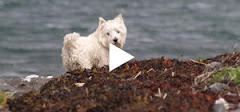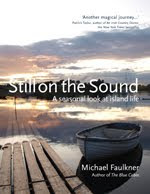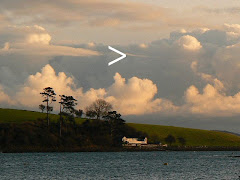 As his mooring barge has been on hire to Marine Current Turbines for a week or so, John Scott has had an inside line on the timing of developments in this promising experiment in harnessing tidal power (uniquely, it’s promising whatever side of the conservation fence you are on, because it has the potential to take the world a step closer to the holy grail of sustainable, green, carbon-neutral energy - more on this below).
As his mooring barge has been on hire to Marine Current Turbines for a week or so, John Scott has had an inside line on the timing of developments in this promising experiment in harnessing tidal power (uniquely, it’s promising whatever side of the conservation fence you are on, because it has the potential to take the world a step closer to the holy grail of sustainable, green, carbon-neutral energy - more on this below).I called John yesterday and he told me that the turbine, and the prodigiously large Belgian crane barge that would drop it into position, had slipped quietly into Strangford Lough on the flood tide before dawn – as quietly, that is, as something can slip in which is tall enough to be logged by air traffic control at George Best Belfast City Airport before leaving Harland and Wolff and moving out of Belfast Lough. John told me that all being well, the operation would take place around dead low water, shortly after 2.00 pm.
Apparently he had a ringside view from one of the support vessels; but if I wanted to get a look by boat while the turbines were still visible, I would have to get a move on. I packed the camera, a pair of binoculars and two extra cans of fuel, and made the narrows in a record-breaking seventeen minutes.
Long before I got there I could see that something really, really, really big was afloat at the southern end of the lough: the twin derricks of the crane towered above the hillocks and trees on both shores, and as I approached the narrows, the Portaferry to Strangford ferry, crossing in front of me, was reduced to almost comical, dinky toy proportions by the barge behind it.
Conditions were perfect as you can see, but in the event, inevitable last minute hitches meant that the window of opportunity passed. (The positioning operation depends on the relative lengths of four cables running to specially-sunk anchor points near the shore, and I understand that three additional 30-ton drums of cable were urgently ordered from Warrenpoint in early afternoon.) From the PR point of view it didn’t matter: there seemed to be a good number of TV and press on the shore south of Portaferry, but the bright afternoon sun, the colour, the scale of the rig and of course the turbine itself, hanging Damocles-like over the water, provided all the spectacle they could wish for.
 When it goes operational, the SeaGen Tidal System, designed and built by Marine Current Turbines of Bristol, will use the narrows' eight-knot tidal run to deliver enough electricity for a thousand homes; and the long term aim is that this and other tidal bottlenecks will provide up to 10% of Northern Ireland’s power needs within five years; indeed, the same percentage figure is claimed for the UK as a whole using sites like the Solway Firth and the Skerries, off Anglesey.
When it goes operational, the SeaGen Tidal System, designed and built by Marine Current Turbines of Bristol, will use the narrows' eight-knot tidal run to deliver enough electricity for a thousand homes; and the long term aim is that this and other tidal bottlenecks will provide up to 10% of Northern Ireland’s power needs within five years; indeed, the same percentage figure is claimed for the UK as a whole using sites like the Solway Firth and the Skerries, off Anglesey. From the point of view of environmental impact, this is unproven technology, but the concensus among conservationists seems to be, a) Shame that it had to be trialed in Northern Ireland’s only Marine Nature Reserve but b) Let’s wait, monitor and hope for the best. A £2m environmental assessment project began two years ago, involving Queen’s University and the Sea Mammal Research Unit at St.Andrews, and is ongoing. The biggest worry is for seals, basking sharks, porpoises etc – anything large enough to be at risk from the twin rotars (each rotar is sixteen metres from tip to tip, and they will turn at around fourteen revolutions a minute). Young seals in particular are notoriously inquisitive, as we found out when a grey seal joined us at The Blue Cabin for a few weeks in December – see my video post from 31 December http://thebluecabin.blogspot.com/2007_12_01_archive.html
From the point of view of environmental impact, this is unproven technology, but the concensus among conservationists seems to be, a) Shame that it had to be trialed in Northern Ireland’s only Marine Nature Reserve but b) Let’s wait, monitor and hope for the best. A £2m environmental assessment project began two years ago, involving Queen’s University and the Sea Mammal Research Unit at St.Andrews, and is ongoing. The biggest worry is for seals, basking sharks, porpoises etc – anything large enough to be at risk from the twin rotars (each rotar is sixteen metres from tip to tip, and they will turn at around fourteen revolutions a minute). Young seals in particular are notoriously inquisitive, as we found out when a grey seal joined us at The Blue Cabin for a few weeks in December – see my video post from 31 December http://thebluecabin.blogspot.com/2007_12_01_archive.htmlIf there is any increase in the number of dead or injured seals, it will fall to the excellent seal rescue team at Exploris Aquarium to pick up the pieces, so at least we will be aware.
MF














